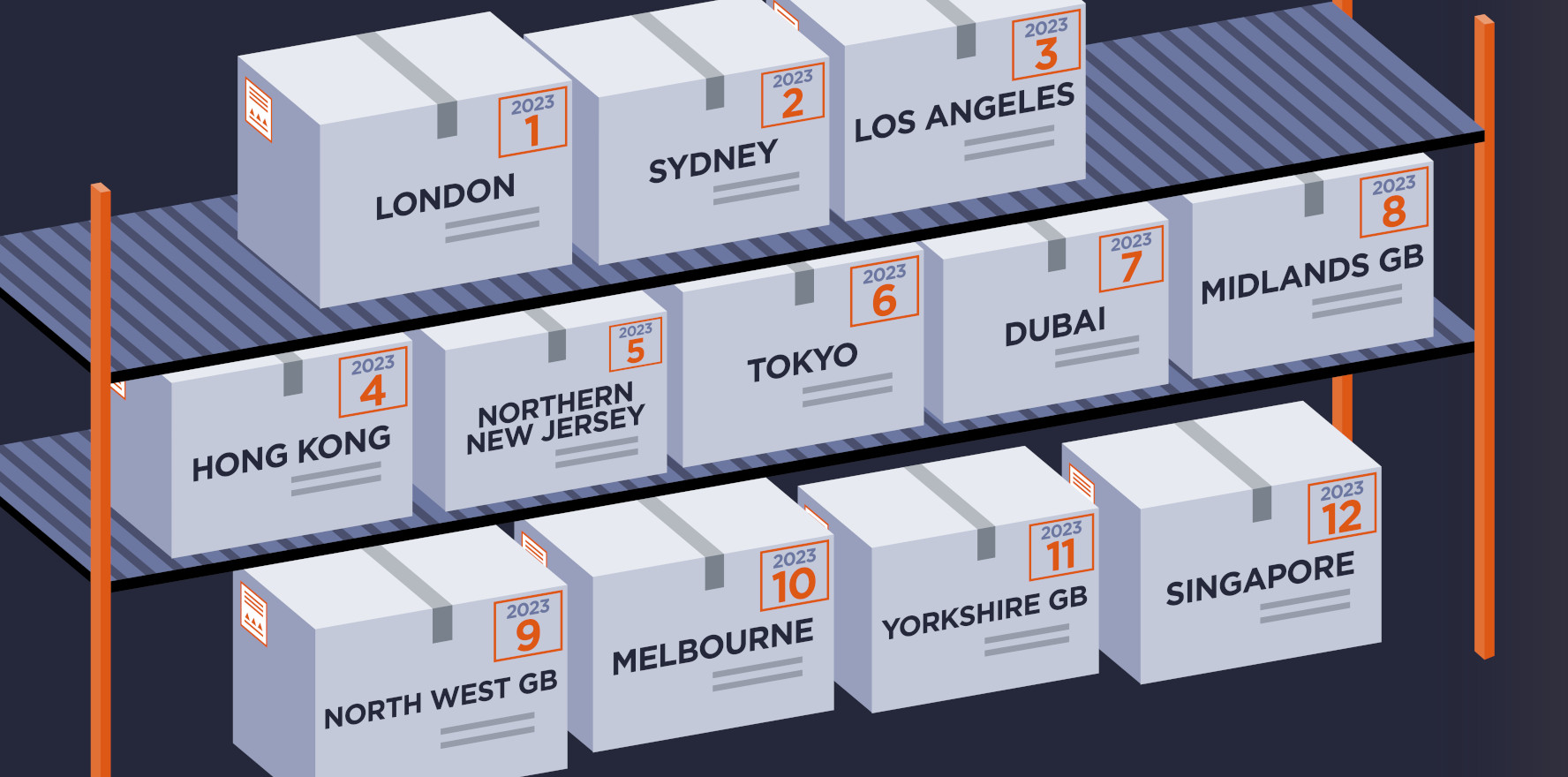Many eyes have been on the warehousing sector in the recent years. The spike in ecommerce during the pandemic, followed by the uptick in manufacturing and supply chain bottlenecks in the recovery saw occupier demand surge. Total prime warehousing property costs, comprising rents, service charges and taxes, grew by 10.1% in the 12 months to June 2023 across 52 global markets we monitor. Rental growth continues to outstrip inflation; prime rents alone were up by 11.8% over the same period.
This annual trend hides slowing, but still strong, rental growth in the first six months of this year, with total costs rising by 4.4%, compared to the 5.4% recorded in the second half of 2022. It comes as vacancy rates rise from historic lows amidst a weak economic backdrop, while more supply enters the market. How has performance varied around the world, and what next for the sector?
The most expensive warehousing markets
London holds the top spot for total prime warehousing property costs at $42 per square foot for prime space (comprising of rents, taxes and service charges). Vacancy rates here have ticked up, but remain below pre-Covid levels as occupiers seek modern units for operational efficiencies and to fulfil ESG criteria.
Like London, Sydney faces land constraints and vacancy rates are exceptionally low, under 1%. As a result, costs have increased by 25.4% in the 12 months to June 2023, pushing it to second position for prime warehousing costs globally, at $27 per square foot.
Los Angeles ranks third. In the US, rental growth is moderating as vacancy rates rise from their historic lows, driven by new construction, but are still below pre-Covid levels in most markets. Mark Russo, Head of Industrial Research, Savills North America, says, “Fundamentals in the US remain solid; ecommerce growth is rising and construction spending by the manufacturing industry is up 76% year on year, driven by the semi-conductor, electric vehicle and clean energy sectors.”
Other notable movers and shakers include Rotterdam, up 8 places to 22nd as costs rose 21.1% in a highly supply constrained market that has seen demand increase as nearshoring benefits Europe’s biggest port. In Germany, which benefits from a strong manufacturing base, Hamburg has moved up 9 places to 19th, and Dusseldorf has risen 7 places to 25th following cost increases of 22.3% and 17.6% respectively.
Global warehousing costs rankings by year: top 12 markets
Prime warehouses: rents, service charges and taxes, compared in USD at prevailing exchange rates
Source: Savills Research
Value in Asia
More moderate warehousing property costs growth of 5.3% was seen in Asia Pacific where, Australia aside, the supply demand imbalance is less acute.
In China, rents are flat, the warehousing market feeling the effects of slower economic expansion and weaker consumer sentiment set against rising supply. Costs vary significantly; Beijing’s are on par with German cities at $11 per square foot, in Chengdu they are among the lowest measured here, under $5 per square foot.
The regional outlook remains positive, particularly given rising ecommerce penetration and trends in nearshoring and onshoring. That’s especially the case in India, where costs are the lowest of the 52 markets tracked, at between $3 and $4 per square foot. India’s manufacturing sector has already witnessed a significant surge in activity, fuelled by incentive such as the Production Linked Incentive Scheme, boosting warehouse demand.
Still room for growth?
For a warehouse occupier, rents are only a portion of the cost picture. Labour costs are the largest component of operational costs, and tight labour markets have continued to drive them up. Warehouse worker wage costs rose by 7.4% in the 12 months to June 2023 across the 52 markets examined, though the rate of this increase slowed in the first half of this year in line with slowing inflation pressures more broadly.
Electricity and diesel costs (for the running of buildings and vehicle fleets) are also a major factor in warehousing operations, and these are diverging. Diesel costs are falling, but electricity costs continue to rise.
While the rate of increases may be slowing, higher costs are here to stay. That only increases occupier emphasis on the best located, most efficient warehousing space, underpinning future demand for prime warehouses and in turn future rental growth. Looking ahead, Kevin Mofid, Head of EMEA Industrial and Logistics Research says “the key structural driver of increased online retail remains in place, and demand from manufacturing-related occupiers will continue to rise as companies look to de-risk their supply chains.”
Policy to encourage domestic manufacturing will be another driver of growth. Europe’s share of semiconductor production will need to more than double to reach the EU Chips Acts targets, for example. If successful, that would equate to up to 10.8m square metres (116.3 million square feet) of additional logistics demand by 2030.
In the longer term, population growth will fuel demand for goods and services, and in turn warehouse requirements, not only in developing economies where populations are rising fastest, but in the growth hotspots of developed ones. Drawing on research in the UK, Mofid adds “each new household requires 69 square feet of warehouse space, which means that an additional 224 million square feet of space will be needed by 2033 to meet the needs of the growing UK population alone.”
Prime warehousing costs league
Source: Savills Research
Investment in the global logistics sector in Q2 2023 was nearly 10% above the equivalent Q2 level in 2019. Read more about the global logistics investment market here.



